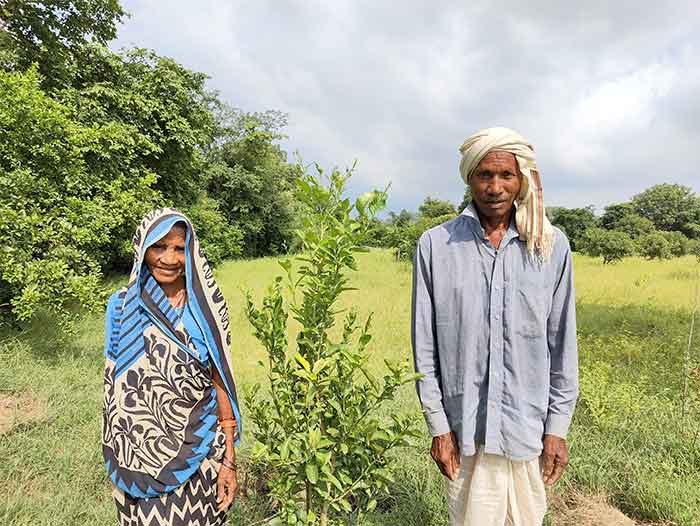
Even though Satai village is located close to a town, the land belonging to several dalit households had been denied irrigation opportunities for a long time and so could not be cultivated properly. Recently Haritika voluntary organization brought new hope by creating a tank with the enthusiastic involvement of people of this hamlet located in Bijawar block of Chattarpur district ( Madhya Pradesh).
This was followed by the planting of trees of high nutrition fruits like anvla, lemon and guava on a part of farmland and the planting of sheesham, sagwan, mahua, tendu, and peepal trees on community land. Haritika activist Sandeep Khare says–within a short time the livelihood base as well as the greenery in and around the dalit habitation improved significantly.
There are several other efforts in Bijawar block where the Haritika acting on its own or in cooperation with other voluntary organizations like Srijan has contributed to sustainable improvements in livelihoods and protection of environment by combining water conservation, tree planting and natural farming.
Kasaar village has a big tank but its capacity had been eroded by the accumulation of silt over several years. With the help of Srijan, activist of Haritika organization mobilized the community here for various aspects of cleaning the tank and silt removal, to be followed by deposition of fertile silt in their fields by the farmers themselves. Various aspects of the plan were discussed at length by the community and responsibilities were assigned. The result , Gautam Chaudhary of Haritika explains, was that there was good coordination between removal of silt and its beneficial use by farmers. What is more, the work of silt removal could continue further later when more opportunities for this became available under a project of Niti Ayog.
Later the initial achievement of water conservation and fertile silt deposition in fields was strengthened further with the spread of natural farming. Initially some of the farmers were skeptical about this and adverse weather added further to difficulties. However in the case of groundnut and sesame the results achieved by natural farming even at an early stage and despite adverse weather were encouraging and this encouraged some farmers to explore the possibilities of natural farming further. Over the last three years about half of the villagers have adopted natural farming to at least some extent.
In Lakhanguvan village encouraging results have emerged from the involvement of women self-help group members organized under the rural livelihood mission. These women farmers have achieved good yields of vegetables and water melons and some of them have also received organic produce certification. A natural farming centre set up here to make available organic fertilizer and pest repellant to those who cannot produce it on their own farms has contributed further to the spread of natural farming. Women have also shown much initiative of marketing of produce and successfully handled this aspect on their own.
In Vijaypur village a big tank created with the involvement has benefited not just this village but even neighboring villages like Jakhron Kalan and Jakhron Khurd. Such efforts also involve the convergence of the resources and efforts of several organizations to make available many-sided benefits and to scale up the contribution. In fact sometimes even at the level of a single field such convergence can be seen.
In Ramnagar village Halkibai and Kariman, an adivasi couple, are very enthused regarding the increase in income they could achieve by creating an orchard of fruit trees. In this orchard they have about 1400 trees of mango, guava, lemon, anvla and jackfruit. Apart from providing plenty of high nutrition fruits to their extended family, their annual earnings from sale of fruits are estimated at around Rs. 60,000. A solar pump has added further to the improved potential of this orchard. Halkibai and Kariman are looking forward to extending this orchard to their other piece of farmland in this village and to constructing a shady cottage which can help them to spend longer time in more comfortable conditions at the orchard. They are devoted to the trees here and nurture them with great care.
It is a beautiful, hope-giving orchard and the resources from several sources have been pooled here to make this possible under the convergence model. Ultimately, it is the commitment and dedication of Halkibai and Kariman which makes the orchard such a big success in a remote village.
Activist from Haritika, Angita Raghuvanshi is very upbeat about the highly encouraging response of adivasi farmers such as this couple. Speaking about the experience of another village in Hata block of neighboring Damoh district, she says that to create a tank, members of the tribal community brought big stones from a considerable distance. Once assured of irrigation from this tank, the adivasis showed great learning and adapting abilities to create very productive and beautiful multi-layer vegetable gardens.
Haritika organization is now moving fast in the direction of very large-scale planting of trees under a carbon credit scheme and Bijawar is becoming a big centre for this. In Malgoje ashram (Amrautia village) nearly 15,000 trees have been planted in recent times. Water conservation work has been taken up nearby. Ashram inmates said that the survival rate has been around 80 per cent and villagers have the freedom to collect fruits even though the ashram is a gated place. As carbon credit programs have their own dynamics, special care will have to be taken to continue the high levels of community participation and involvement. The decision taken to plant only indigenous trees should also maintained.
Bharat Dogra is Honorary Convener, Campaign to Save Earth Now. His recent books include Planet in Peril, Man over Machine and India’s Quest for Sustainable Farming and Healthy Food.










































